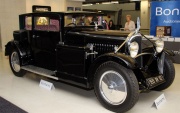Avions Voisin





WWI After its major expansion into military airplanes, the name of aviation pioneer Gabriel Voisin's company was changed from Appareils d'Aviation, Les Freres Voisin to Avions Voisin.
After the war, Voisin abandoned aeroplane manufacture and concentrated on automobile manufacture, citing the trauma of the military use of his more advanced airplanes during the war in addition to the, then embryonic, demand for civilian aircraft.
The Avions Voisin was a French luxury automobile brand.
1919 Gabriel B. Voisin started producing cars using Knight-type sleeve valve engines at Issy-les-Moulineaux, an industrial suburb to the South West of Paris. A former student of the Fine Arts School of Lyon and enthusiast for all things mechanical since his childhood, Voisin's uncompromisingly individual designs made extensive use of light alloys, especially aluminum.
One of the company's most striking early designs was the Laboratoire Grand Prix car of 1923; one of the first cars ever to use monocoque chassis construction, and utilising small radiator-mounted propeller to drive the cooling pump. The characteristic Voisin style of 'rational' coachwork he developed in conjunction with his collaborator André Noel-Noel prioritized lightness, central weight distribution, capacious luggage boxes and distinctively angular lines.
1923 British concessionaires were Maxwell Monson and Curtis Automobile Co.
Voisin's early cars were some of the finest luxury vehicles in the world, with unique technical details. Many of them won in competition.
The 1930s models with underslung chassis were strikingly low in profile.
In the early 1930s, Gabriel Voisin could not pay all of his draughtsmen any more and a young creative engineer called André Lefèbvre quit, recommended by Gabriel to Louis Renault. Lefèbvre finally entered Citroën where he conducted the three most profitable car projects of the firm: the Traction Avant, the 2CV and the DS, using a lot of Gabriel's lessons.
The luxury car market shrank in the late 1930s because of depressed economic conditions and Voisin closed his factory.
Voisins luxury automobile manufacturing continued until 1958.
See Also
Sources of Information
- [1] Wikipedia

